Changes in the Plantar Flexion Torque of the Ankle and in the Morphological Characteristics and Mechanical Properties of the Achilles Tendon after 12-Week Gait Retraining
Abstract
1. Introduction
2. Methods
2.1. Participants
2.2. Instrumentations
2.3. Procedures
2.4. GR Intervention
2.5. Data Analysis
2.6. Statistics
3. Results
3.1. Ankle Torque during MVIC
3.2. AT Morphology
3.3. AT Mechanical Properties
4. Discussion
5. Conclusions
Author Contributions
Funding
Conflicts of Interest
References
- Mucha, M.D.; Caldwell, W.; Schlueter, E.L.; Walters, C.; Hassen, A. Hip abductor strength and lower extremity running related injury in distance runners: A systematic review. J. Sci. Med. Sport 2017, 20, 349–355. [Google Scholar] [CrossRef]
- The State of Running 2019. Available online: https://runrepeat.com/state-of-running (accessed on 15 June 2020).
- Fries, J.F.; Singh, G.; Morfeld, D.; Hubert, H.B.; Lane, N.E.; Brown, B.W. Running and the Development of Disability with Age. Ann. Intern. Med. 1994, 121, 502–509. [Google Scholar] [CrossRef]
- Davis, I.S.; Rice, H.M.; Wearing, S.C. Why forefoot striking in minimal shoes might positively change the course of running injuries. J. Sport Health Sci. 2017, 6, 154–161. [Google Scholar] [CrossRef]
- Lopes, A.D.; Hespanhol Junior, L.C.; Yeung, S.S.; Costa, L.O. What are the main running-related musculoskeletal injuries? A Systematic Review. Sports Med. 2012, 42, 891–905. [Google Scholar] [CrossRef]
- Freedman, B.R.; Gordon, J.A.; Soslowsky, L.J. The Achilles tendon: Fundamental properties and mechanisms governing healing. Muscles Ligaments Tendons J. 2014, 4, 245–255. [Google Scholar] [CrossRef]
- Cigoja, S.; Asmussen, M.J.; Firminger, C.R.; Fletcher, J.R.; Edwards, W.B.; Nigg, B.M. The Effects of increased midsole bending stiffness of sport shoes on muscle-tendon unit shortening and shortening velocity: A randomised crossover trial in recreational male runners. Sports Med. Open 2020, 6, 1–11. [Google Scholar] [CrossRef] [PubMed]
- Pizzolato, C.; Lloyd, D.G.; Zheng, M.H.; Besier, T.F.; Shim, V.B.; Obst, S.J.; Newsham-West, R.; Saxby, D.J.; Barrett, R.S. Finding the sweet spot via personalised Achilles tendon training: The future is within reach. Br. J. Sports Med. 2019, 53, 11–12. [Google Scholar] [CrossRef] [PubMed]
- Zhang, X.N.; Wang, J.Q.; Yang, Y.; Fu, W.J. Effects of barefoot running on achilles tendon mechanical properties. China Sport Sci. 2019, 39, 63–70. [Google Scholar]
- Pizzolato, C.; Lloyd, D.G.; Barrett, R.S.; Cook, J.L.; Zheng, M.H.; Besier, T.F.; Saxby, D.J. Bioinspired technologies to connect musculoskeletal mechanobiology to the person for training and rehabilitation. Front. Comput. Neurosci 2017, 11, 96. [Google Scholar] [CrossRef] [PubMed]
- Santos-Concejero, J.; Tam, N.; Granados, C.; Irazusta, J.; Bidaurrazaga-Letona, I.; Zabala-Lili, J.; Gil, S.M. Interaction effects of stride angle and strike pattern on running economy. Int. J. Sports Med. 2014, 35, 1118–1123. [Google Scholar] [CrossRef]
- Futrell, E.E.; Gross, K.D.; Reisman, D.; Mullineaux, D.R.; Davis, I.S. Transition to forefoot strike reduces load rates more effectively than altered cadence. J. Sport Health Sci. 2020, 9, 248–257. [Google Scholar] [CrossRef]
- Latorre-Roman, P.A.; Garcia-Pinillos, F.; Soto-Hermoso, V.M.; Munoz-Jimenez, M. Effects of 12 weeks of barefoot running on foot strike patterns, inversion-eversion and foot rotation in long-distance runners. J. Sport Health Sci. 2019, 8, 579–584. [Google Scholar] [CrossRef]
- Joseph, M.F.; Histen, K.; Arntsen, J.; L’Hereux, L.; Defeo, C.; Lockwood, D.; Scheer, T.; Denegar, C.R. Achilles tendon adaptation during transition to a minimalist running style. J. Sport Rehabil. 2017, 26, 165–170. [Google Scholar] [CrossRef] [PubMed]
- Rice, H.; Patel, M. Manipulation of foot strike and footwear increases achilles tendon loading during running. Am. J. Sports Med. 2017, 45, 2411–2417. [Google Scholar] [CrossRef] [PubMed]
- Ahn, A.N.; Brayton, C.; Bhatia, T.; Martin, P. Muscle activity and kinematics of forefoot and rearfoot strike runners. J. Sport Health Sci. 2014, 3, 102–112. [Google Scholar] [CrossRef]
- Faul, F.; Erdfelder, E.; Lang, A.-G.; Buchner, A. G*Power 3: A flexible statistical power analysis program for the social, behavioral, and biomedical sciences. Behav. Res. Methods 2007, 39, 175–191. [Google Scholar] [CrossRef] [PubMed]
- Wang, B.; Yang, Y.; Zhang, X.; Wang, J.; Deng, L.; Fu, W. Twelve-week gait retraining reduced patellofemoral joint stress during running in male recreational runners. Biomed. Res. Int. 2020, 2020, 9723563. [Google Scholar] [CrossRef] [PubMed]
- Yang, Y.; Zhang, X.; Luo, Z.; Wang, X.; Ye, D.; Fu, W. Alterations in running biomechanics after 12 week gait retraining with minimalist shoes. Int. J. Environ. Res. Public Health 2020, 17, 818. [Google Scholar] [CrossRef] [PubMed]
- Stafilidis, S.; Sickinger, C. Anterior subject positioning affects the maximal exerted isometric plantar flexion moment. PLoS ONE 2019, 14, e0219840. [Google Scholar] [CrossRef]
- Histen, K.; Arntsen, J.; L’Hereux, L.; Heeren, J.; Wicki, B.; Saint, S.; Aerni, G.; Denegar, C.R.; Joseph, M.F. Achilles tendon properties of minimalist and traditionally shod runners. J. Sport Rehabil. 2017, 26, 159–164. [Google Scholar] [CrossRef]
- Komi, P.V. Relevance of in vivo force measurements to human biomechanics. J. Biomech. 1990, 23, 23–25, 27–34. [Google Scholar] [CrossRef]
- Joseph, M.F.; Lillie, K.R.; Bergeron, D.J.; Denegar, C.R. Measuring achilles tendon mechanical properties: A reliable, noninvasive method. J. Strength Cond. Res. 2012, 26, 2017–2020. [Google Scholar] [CrossRef] [PubMed]
- Liebl, D.; Willwacher, S.; Hamill, J.; Brüggemann, G.P. Ankle plantarflexion strength in rearfoot and forefoot runners: A novel clusteranalytic approach. Hum. Mov. Sci. 2014, 35, 104–120. [Google Scholar] [CrossRef] [PubMed]
- Lyght, M.; Nockerts, M.; Kernozek, T.W.; Ragan, R. Effects of foot strike and step frequency on achilles tendon stress during running. J. Appl. Biomech. 2016, 32, 365–372. [Google Scholar] [CrossRef] [PubMed]
- Perl, D.P.; Daoud, A.I.; Lieberman, D.E. Effects of footwear and strike type on running economy. Med. Sci. Sports Exerc. 2012, 44, 1335–1343. [Google Scholar] [CrossRef] [PubMed]
- Arampatzis, A.; Karamanidis, K.; Albracht, K. Adaptational responses of the human Achilles tendon by modulation of the applied cyclic strain magnitude. J. Exp. Biol. 2007, 210, 2743–2753. [Google Scholar] [CrossRef] [PubMed]
- Henriksen, M.; Aaboe, J.; Bliddal, H.; Langberg, H. Biomechanical characteristics of the eccentric Achilles tendon exercise. J. Biomech. 2009, 42, 2702–2707. [Google Scholar] [CrossRef] [PubMed]
- Daoud, A.I.; Geissler, G.J.; Wang, F.; Saretsky, J.; Daoud, Y.A.; Lieberman, D.E. Foot strike and injury rates in endurance runners: A retrospective study. Med. Sci. Sports Exerc. 2012, 44, 1325–1334. [Google Scholar] [CrossRef]
- Magnan, B.; Bondi, M.; Pierantoni, S.; Samaila, E. The pathogenesis of Achilles tendinopathy: A systematic review. Foot Ankle Surg. 2014, 20, 154–159. [Google Scholar] [CrossRef]
- Grindstaff, T.L.; Palimenio, M.R.; Franco, M.; Anderson, D.; Bagwell, J.J.; Katsavelis, D. Optimizing between-session reliability for quadriceps peak torque and rate of torque development measures. J. Strength Cond. Res. 2019, 33, 1840–1847. [Google Scholar] [CrossRef]
- Muraoka, T.; Muramatsu, T.; Fukunaga, T.; Kanehisa, H. Elastic properties of human Achilles tendon are correlated to muscle strength. J. Appl. Physiol. 2005, 99, 665–669. [Google Scholar] [CrossRef] [PubMed][Green Version]
- Maas, E.; Jonkers, I.; Peers, K.; Vanwanseele, B. Achilles tendon adaptation and Achilles tendinopathy in running. OA Orthop. 2014, 2, 25. [Google Scholar]
- Arampatzis, A.; Peper, A.; Bierbaum, S.; Albracht, K. Plasticity of human Achilles tendon mechanical and morphological properties in response to cyclic strain. J. Biomech. 2010, 43, 3073–3079. [Google Scholar] [CrossRef] [PubMed]
- Magnusson, S.P.; Kjaer, M. Region-specific differences in Achilles tendon cross-sectional area in runners and non-runners. Eur. J. Appl. Physiol. 2003, 90, 549–553. [Google Scholar] [CrossRef] [PubMed]
- Magnusson, S.P.; Narici, M.V.; Maganaris, C.N.; Kjaer, M. Human tendon behaviour and adaptation, in vivo. J. Physiol. 2008, 586, 71–81. [Google Scholar] [CrossRef]
- Thusen, A.H. Rearfoot Biomechanics in Achilles Tendon Function. Master’s Thesis, University of Salford, Salford, Manchester, UK, 2015. [Google Scholar]

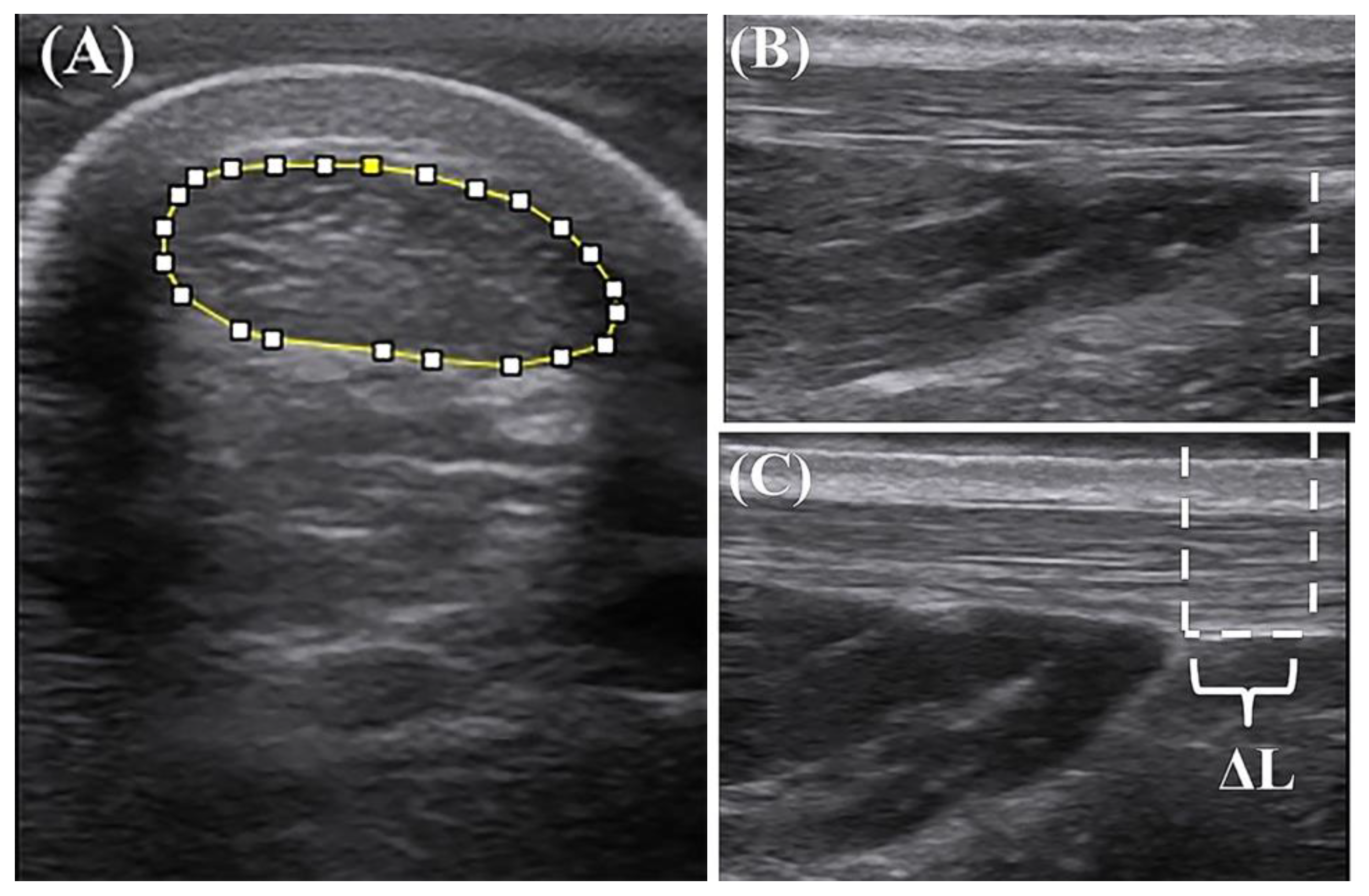
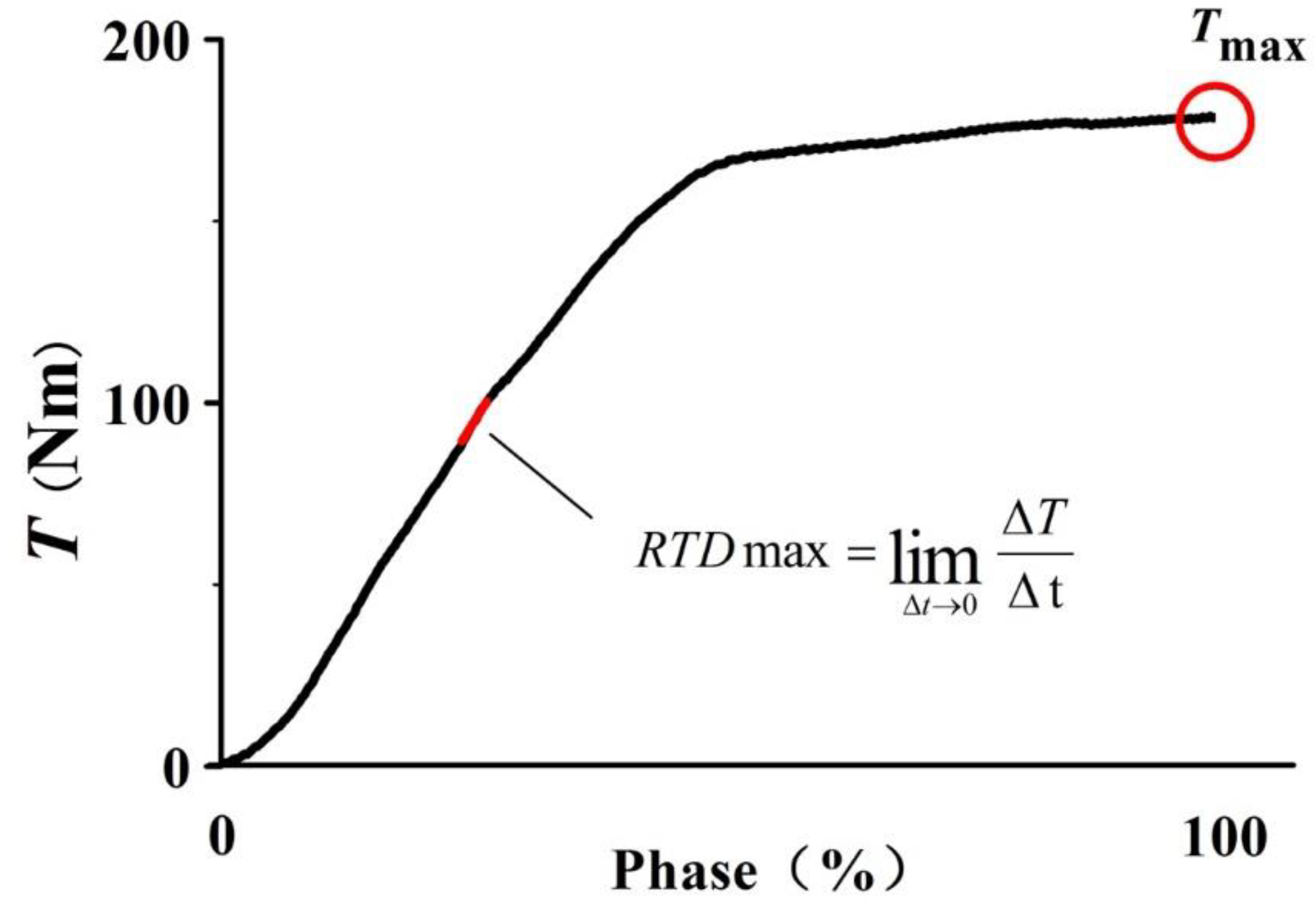
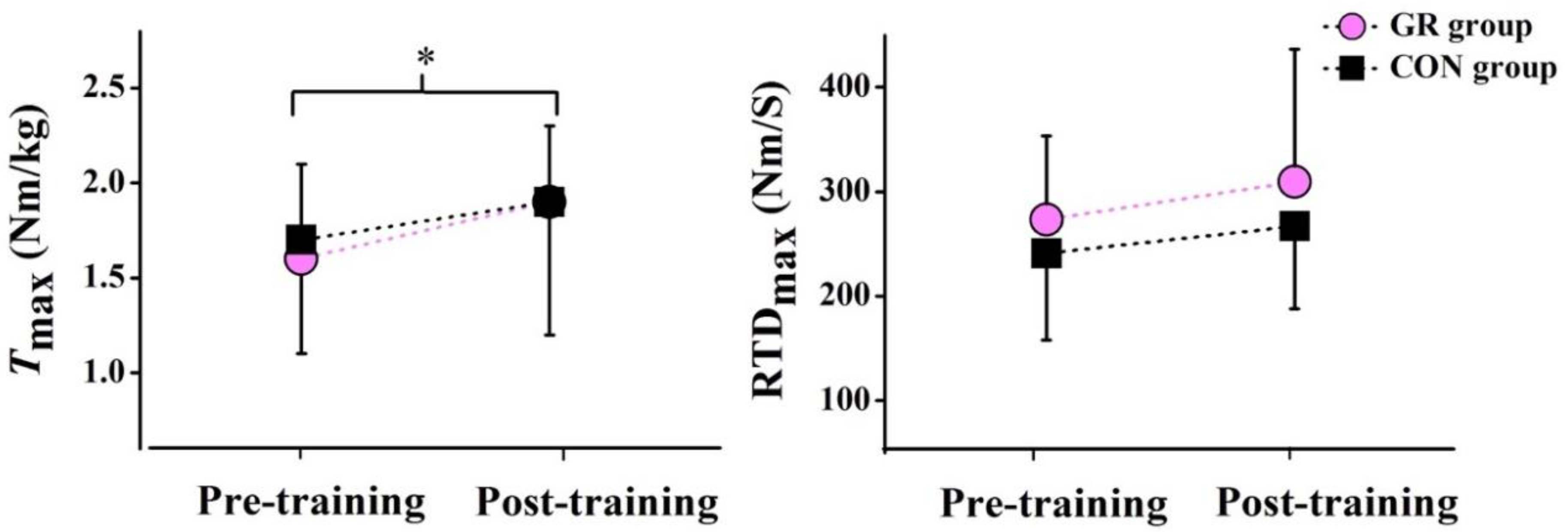
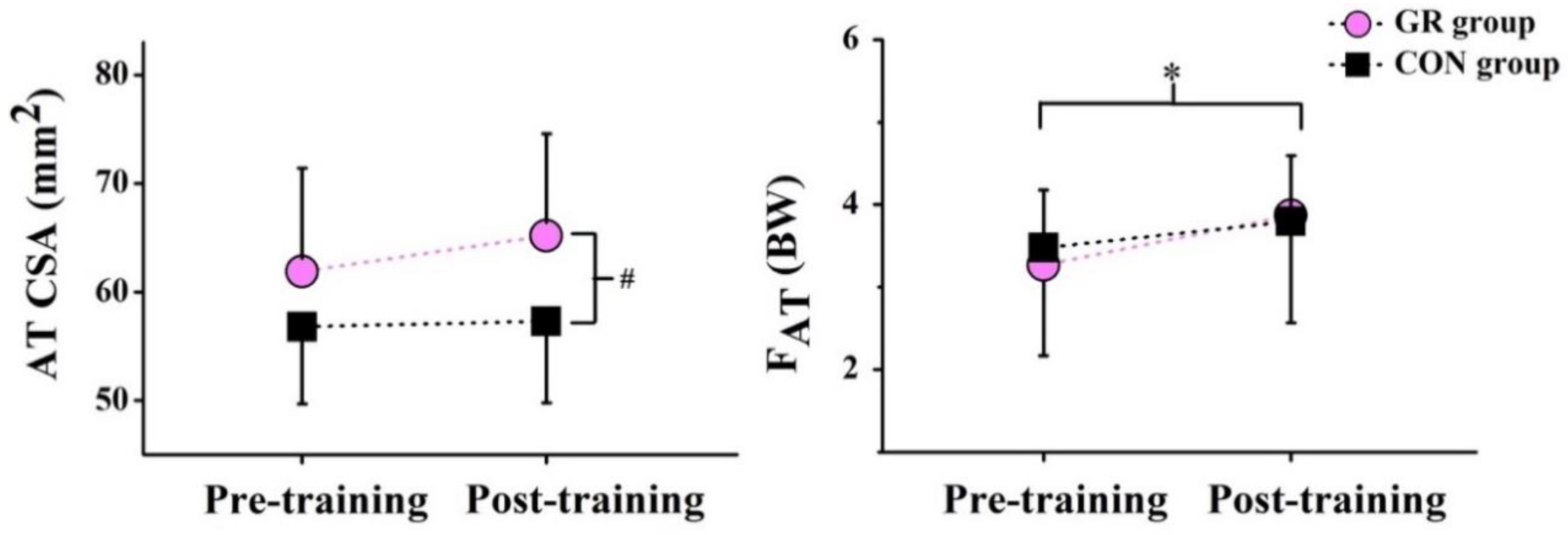
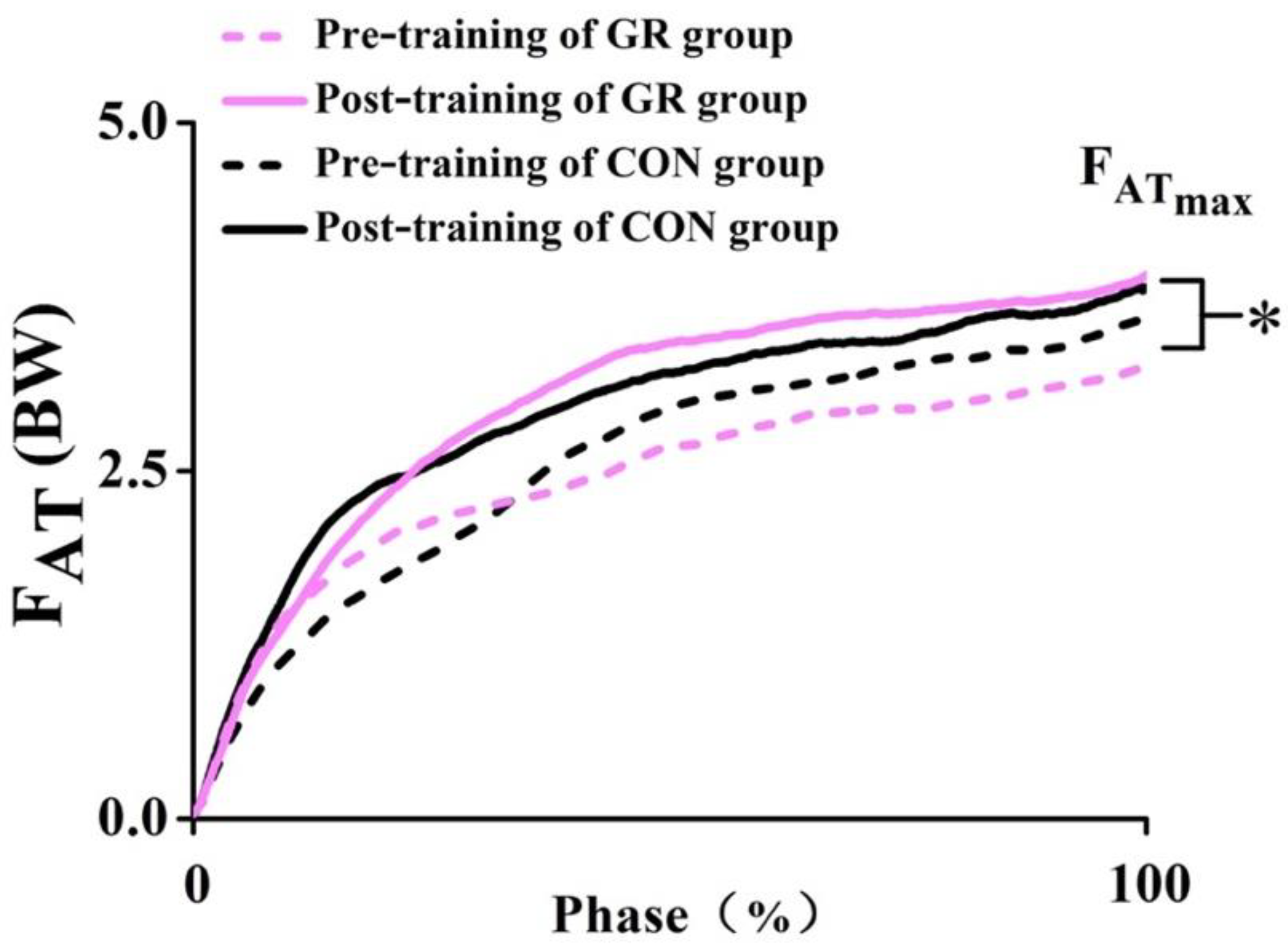
| Group | Sample Size (n) | Age (years) | Height (cm) | Weight (kg) |
|---|---|---|---|---|
| GR | 20 | 31.3 ± 3.5 | 175.7 ± 2.6 | 70.9 ± 3.8 |
| CON | 14 | 26.6 ± 5.8 | 175.6± 2.3 | 72.7 ± 4.3 |
| Parameters | GR Group | Percent Change | CON Group | Percent Change | p Value | ||||
|---|---|---|---|---|---|---|---|---|---|
| Pre-Training | Post-Training | Pre-Training | Post-Training | Main Effect for Time | Main Effect for Group | Interaction Effect | |||
| Tmax (Nm/kg) | 1.6 ± 0.5 | 1.9 ± 0.7 * | 27.5% | 1.7 ± 0.4 | 1.9 ± 0.4 * | 10.4% | 0.005 | 0.843 | 0.356 |
| RTDmax (Nm/s) | 273.5 ± 79.7 | 309.4 ± 127.0 | 17.3% | 241.0 ± 82.8 | 267.0 ± 79.1 | 17.5% | 0.074 | 0.212 | 0.792 |
| CSA (mm2) | 61.9 ± 9.5 # | 65.2 ± 9.4 # | 6.3% | 56.8 ± 7.1 | 57.3 ± 7.5 | 1.0% | 0.081 | 0.027 | 0.216 |
| LAT (mm) | 77.4 ± 18.1 | 76.8 ± 18.3 | −0.6% | 76.9 ± 12.5 | 77.8 ± 12.2 | 0.9% | 0.776 | 0.963 | 0.240 |
| ΔL (mm) | 15.9 ± 6.5 | 18.9 ± 5.2 | 36.9% | 16.4 ± 4.9 | 16.5 ± 4.7 | 8.1% | 0.166 | 0.529 | 0.199 |
| Peak FAT (BW) | 3.3 ± 1.1 | 3.9 ± 1.3 * | 27.5% | 3.5 ± 0.8 | 3.8 ± 0.8 * | 10.4% | 0.005 | 0.843 | 0.356 |
| AT stress (MPa) | 38.6 ± 13.8 | 43.0 ± 13.5 | 20.4% | 42.2 ± 11.2 | 43.9 ± 11.5 | 5.5% | 0.069 | 0.493 | 0.191 |
| AT strain (%) | 21.9 ± 11.6 | 25.7 ± 8.7 | 37.5% | 21.9 ± 7.7 | 21.8 ± 7.0 | 7.1% | 0.234 | 0.493 | 0.191 |
© 2020 by the authors. Licensee MDPI, Basel, Switzerland. This article is an open access article distributed under the terms and conditions of the Creative Commons Attribution (CC BY) license (http://creativecommons.org/licenses/by/4.0/).
Share and Cite
Deng, L.; Zhang, X.; Xiao, S.; Yang, Y.; Li, L.; Fu, W. Changes in the Plantar Flexion Torque of the Ankle and in the Morphological Characteristics and Mechanical Properties of the Achilles Tendon after 12-Week Gait Retraining. Life 2020, 10, 159. https://doi.org/10.3390/life10090159
Deng L, Zhang X, Xiao S, Yang Y, Li L, Fu W. Changes in the Plantar Flexion Torque of the Ankle and in the Morphological Characteristics and Mechanical Properties of the Achilles Tendon after 12-Week Gait Retraining. Life. 2020; 10(9):159. https://doi.org/10.3390/life10090159
Chicago/Turabian StyleDeng, Liqin, Xini Zhang, Songlin Xiao, Yang Yang, Lu Li, and Weijie Fu. 2020. "Changes in the Plantar Flexion Torque of the Ankle and in the Morphological Characteristics and Mechanical Properties of the Achilles Tendon after 12-Week Gait Retraining" Life 10, no. 9: 159. https://doi.org/10.3390/life10090159
APA StyleDeng, L., Zhang, X., Xiao, S., Yang, Y., Li, L., & Fu, W. (2020). Changes in the Plantar Flexion Torque of the Ankle and in the Morphological Characteristics and Mechanical Properties of the Achilles Tendon after 12-Week Gait Retraining. Life, 10(9), 159. https://doi.org/10.3390/life10090159





